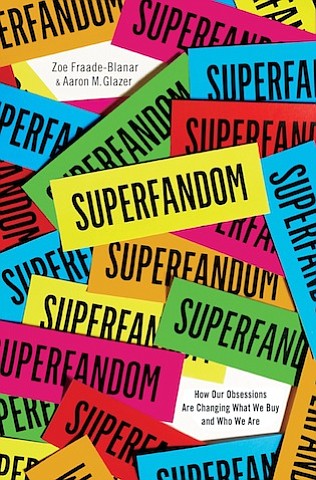“Superfandom: How Our Obsessions Are Changing What We Buy and Who We"
Terri Schlichenmeyer | 4/28/2017, 1:24 p.m.

Collect them all.
Those three words put a smile on every marketer’s face and fear in every parent’s heart. “Collect them all,” as you may remember, was kid-code for “bug your parents until they buy stuff,” making you the envy of everyone in third grade. Your goal now: to capture that buyer’s obsession at the level you’ll see in “Superfandom” by Zoe Fraade-Blanar & Aaron M. Glazer.
Star Wars is just a movie.
To its billions of fans, that statement may seem like blasphemy. To them, Han Solo, Princess Leia, and Chewbacca are so much more, and fans prove it with masks, mugs, mats, and memorabilia they’ve purchased since 1977, epic plastic light-sabre battles in New York, and fan fiction online.
Obsessions like that, say Fraade-Blanar and Glazer, create “Superfans,” which they describe as “those dedicated and serious members of a fandom who… commit real time, energy, and attention to assisting and improving the fandom they love.” Superfandom is what made an illiterate medieval woman create fan-fiction based on the Bible. It’s why zombies are so hot now. It’s what makes some 40,000 people flock to Omaha each year, for what is basically a “legally required corporate triviality.”
So can you create that kind of obsession?
Superfandom, say the authors works like this: “A Successful Fandom = Critical Mass + Emotional Response + Platform.” In other words, give your most fervent fans a place in which they can tell others why they love your product. Offer a sense of belonging, perhaps with a touch of status. Encourage self-expression with product involvement. Utilize social media to the utmost, take good care of your superfans, and license your product so they can flaunt their passion with apparel and other collectibles.
Above all, say the authors, remember that you can’t fool a fan, you can’t force them to like you, and you can’t insult them without their permission. Always be authentic, but remember that “customers are always right. Fans aren’t.”
Though it’s quite enjoyable, “Superfandom” is unlike most other business books, in that it’s not filled with formulaic advice. Instead, readers learn about making superfans by reading about others who’ve tapped into this new pop-culture-based way of “externally generated branding.”
Certainly, authors Zoe Fraade-Blanar & Aaron M. Glazer know about their subject: they’re co-founders of Squishable, a company that’s driven by superfans. That first-hand knowledge makes for a more focused book, albeit one that leans heavy. An assumption that readers are tech-savvy or pop-culture knowledgeable may also leave some businesspeople feeling adrift.
And yet – help is in here. The authors use abundant cautionary tales to warn marketers away from gaffes, and enough success stories to empower anyone to think carefully of ways that fan-creation may work for them. But will it work for you?
That depends. While there are fans of almost every age, this marketing seems to speak to teens and young adults, so bear that in mind. But if you’re ready to hear the cheers of your fan-base, “Superfandom” will make a nice book for your collection.
Share this story online at www.stylemagazine.com.





